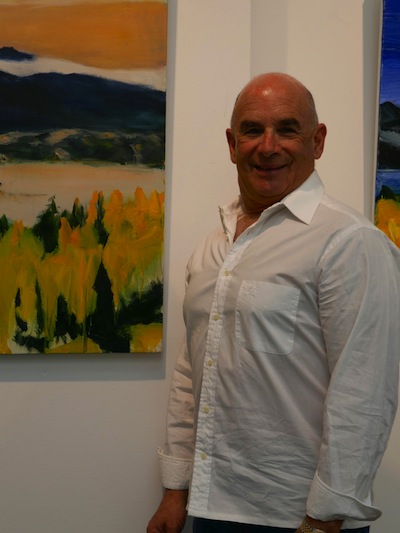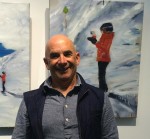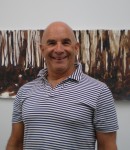“ReView 2” by Ian Penn.
Ian Penn is not a new name for regular visitors to the Zack Gallery, which has exhibited his work before. “I like this gallery,” Penn told the Independent. “It’s like a public marketplace. It’s transparent and open. Children come in. Older people. People on the way from their lunch or the gym. The gallery is accessible, the way art should be. I could show at a traditional gallery, but I don’t want to.”
Penn makes one exception to this statement – for his homeland, Australia. “I have a gallery in Australia that represents me, and I exhibit there frequently, once or twice a year,” he said. “Last year, I was an artist-in-residence at that gallery. I gave artistic workshops to high school children. It was fun.”
His current exhibition at the Zack, From the Deck: View and ReView, is dedicated to landscapes, specifically the scenery he sees from the deck of his house: trees and mountains, water and clouds. Penn has painted these landmarks in different lights and different seasons. “I tried to capture different moods,” he said. “Some are grand, panoramic. Others are smaller, more intimate.”
He explained his idea behind the show. “View and re-view are two parts of the process. I look at the view from my house deck, have been looking at it for years. I enjoy the landscape from a single view. I take photographs. I sketch it multiple times. It’s my immediate response to the landscape. I’m part of it. I’m mapping it. This is ‘View,’ but it is not the territory, just a map. It is my understanding of the place.”
Penn’s View paintings are more abstract, sometimes just splashes of colour. What is important to the artist is that every element appears in the right size and shape in relation to the other elements. “I measure all the distances at this stage and mark the proportions. How far is this treetop from that ship passing through? How large are these bushes compared to that shoreline? I make lots of drawings.”
The second part of the process, the review, is done in the studio, later. “This is the second part of my response,” he explained. “I’d think: what is important in that idea? A ‘ReView’ is my emotional and physical answer to the ‘View’ and the landscape. It’s all about the place itself, the place and the painting. At this stage, I’m recreating the territory.”

Unlike the bold brush strokes of his Views, most of his ReViews are more detailed, while still exploring the same landscape. And the ratio of abstract versus figurative slants towards the figurative. “I’m interested where representation and abstraction interact,” he admitted.
In his ReViews, a tree becomes a more detailed tree, not just a blob of yellow, even while maintaining its impressionistic abstract profile. A ship becomes more identifiable as a ship, not simply a dark squiggle. And a cloud can’t be mistaken for anything else.
In fact, clouds play a huge role in most of the paintings on display: light and fluffy in one image, heavy and menacing in another. “Clouds change constantly; that’s why they interest me. I’m fascinated by change, by periods of transition,” said Penn. “That’s why most of these paintings are done in spring or autumn. Those are the seasons of change. In summer, the landscape is full and the sky is clear, but, with autumn, comes change. The colours of the leaves change. When the leaves fall, the shapes of the trees change. The bones of the landscapes are transformed. The weather changes. Same in spring. By exploring those changes, I’m addressing the changes in our lives.”
By the juxtaposition of constant change within the same view – from one location – Penn follows in the footsteps of one of his favourite artists, Paul Cezanne. “I studied Cezanne. He painted Mont Sainte-Victoire countless times, all different,” Penn said. “He changed the landscape genre forever, took it apart and re-created it.”
Penn’s investigation of the landscape as an art form goes further. “A traditional landscape is horizontal, with certain set dimensions,” he explained. “I’m challenging those dimensions, trying landscapes of different formats. A portrait shape. A diptych, which is much wider than a traditional landscape. I’m playing with different geometry. What if the two parts of a diptych are of different widths: one square, another a wider rectangle? What if both parts are off-squares?”
Penn’s experiments with the shapes of his paintings, with the changing of weather and seasons, makes the show diverse. The exhibition demonstrates the richness of landscape as an art form.
“Landscape as we know it is relatively new in the modern Western art,” he said. “Before the Renaissance, landscape was mostly a background for figures in the composition. It only became a separate art form in the 16th and 17th centuries, after the paint tubes became small enough that artists could take them out of the studios, to paint on locations. That was what the Group of Seven did. That is what I do.”
Penn’s show runs until April 28 at the Zack. For more information about his work, visit ianpenn.com.
Olga Livshin is a Vancouver freelance writer. She can be reached at olgagodim@gmail.com.



